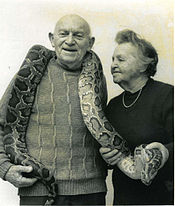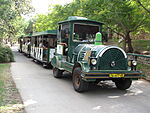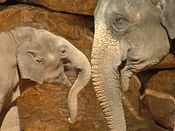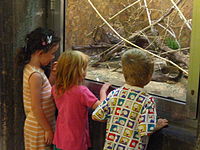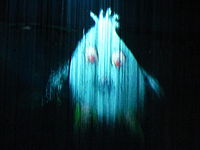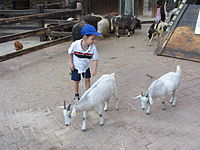- Jerusalem Biblical Zoo
-
Jerusalem Biblical Zoo
Zoo logo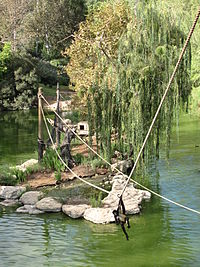
A Black-Handed Spider Monkey swings on a rope over the artificial lake at the zooDate opened 1940 Location Malha, Jerusalem Land area 62 acres[1] Coordinates 31°44′58″N 35°10′37″E / 31.74944°N 35.17694°ECoordinates: 31°44′58″N 35°10′37″E / 31.74944°N 35.17694°E Number of animals 2,200 (as of 2009)[2] Number of species 271 (as of 2009)[2] Memberships WAZA,[3] EAZA,[4] IZA,[5] ISIS[6] Website jerusalemzoo.org.il/len/ The Tisch Family Zoological Gardens in Jerusalem (Hebrew: גן החיות התנ"כי בירושלים על שם משפחת טיש, Arabic: حديقة الحيوان الكتابية في أورشليم القدس Ḥadīqat al-Ḥaiwān al-Kitābiyyah fī 'Urushalīm al-Quds), popularly known as the Jerusalem Biblical Zoo, is a zoo located in the Malha neighborhood of Jerusalem, Israel. It is famous for its collection of wildlife featured in the Hebrew Bible, as well as its success in breeding endangered species.[7] According to Dun and Bradstreet, the Biblical Zoo was the most popular tourist attraction in Israel from 2005 to 2007, and logged a record 738,000 visitors in 2009.[2] The zoo had about 55,000 members in 2009.[8]
Contents
History
The Jerusalem Biblical Zoo opened in September 1940 as a small "animal corner" on Rabbi Kook Street in central Jerusalem.[9][10] The zoo was founded by Aharon Shulov, a professor of zoology at the Hebrew University of Jerusalem, Mount Scopus. Among Shulov's goals were to provide a research facility for his students; to gather animals, reptiles and birds mentioned in the Bible;[10][11] and, as he wrote in 1951, to break down the "invisible wall" between the intellectuals on Mount Scopus and the general public.[12]
Early on, the zoo ran into several difficulties in its decision to focus on animals mentioned in the Bible. For one, the meaning of many names of animals, reptiles and birds in Scriptures is often uncertain; for example, nesher (Hebrew: נשר), commonly translated as "eagle", could also mean "vulture".[9] More significantly, many of the animals mentioned in the Bible are now extinct in Israel due to over-hunting, destruction of natural habitats by rapid construction and development, illegal poisoning by farmers, and low birth rate.[13] Zoo planners decided to branch beyond strictly biblical animals and include worldwide endangered species as well.[9]
Complaints from the neighbors
The presence of the animal corner generated many complaints from residents in adjoining buildings due to the smell and noise, as well as the perceived danger of animal escapes. Due to the complaints, the zoo relocated in 1941 to a 4.5-dunam (1.1-acre) lot on Shmuel Hanavi Street. Here, too, complaints were heard from the neighbors, but the zoo remained at this site for the next six years.[9]
In 1947 the zoo, which by now had 122 animals,[10] relocated to a plot of land on Mount Scopus provided by Hebrew University. It remained there from 1947 to 1950. Its occupancy coincided with the 1948 Arab-Israeli War and the siege of Jerusalem, when food for the city's population was at a premium. Zookeepers resorted to hunting down stray dogs near garbage dumps in order to feed the carnivorous animals. Many of the carnivores died anyway, and other, non-dangerous species had to be released.[9]
As part of the Israel-Jordan Armistice Agreements of 1949, access to Mount Scopus was restricted. The United Nations helped the zoo relocate[9] to a 15-acre (6.1 ha) lot[14] in Givat Komuna, adjacent to the present-day neighborhoods of Romema and Ezrat Torah. According to Shulov, when the zoo arrived in Romema, only two wolves, one hyena, one lion and one leopard were left.[9][15]
The zoo remained in Romema from 1950 to 1991, becoming a beloved Jerusalem institution. About 30 percent of its attendance came from Haredi families from northern Jerusalem and Muslim families from East Jerusalem—two population groups that normally do not participate in the city's cultural offerings.[16] The zoo grew to 28 acres (11 ha) and more than 200 species, including most of the 130 animals mentioned in the Bible. Thanks to its breeding program, 11 species that had disappeared from Israel were reintroduced into nature reserves around the country, including the Syrian brown bear, the addax, and two types of fallow deer. Through gifts, trades with other zoos, and its success at breeding, the zoo's collection exceeded 500 animals by 1967. During the Six-Day War, however, 110 animals were killed by shrapnel and stray bullets.[10]
The zoo was administered by a nonprofit corporation with representatives from Hebrew University, the Jerusalem Municipality, and the Israeli Ministries of Tourism and Education. From a financial standpoint, however, the zoo had little money. Shulov, who retired as director in 1983,[10] often served as director without pay. The zoo was also considered inferior to the zoos of Tel Aviv and Haifa.[9]
Jerusalem mayor Teddy Kollek, who took office in 1965, became one of the zoo's main supporters and fund-raisers through his Jerusalem Foundation.[17] Kollek promoted the idea of moving the zoo to a larger location and upgrading it to a state-of-the-art institution, as well as a tourist site that would appeal to secular and religious Jewish families and Arab families alike.[18] Around 1990, under the auspices of the Jerusalem Foundation, the Tisch family of New York agreed to pay $5 million toward the $30 million cost of the project. Another $10 million was raised through sale of the lot in Romema, which was converted to housing. The Jerusalem municipality, the Israel Ministry of Tourism, the Jerusalem Foundation, and private sponsors also contributed.[16] The zoo closed its site in Romema in 1991 and reopened in the Malha valley, 7 kilometres (4.3 mi) southwest of the city center,[16] in 1993.[9]
The zoo today
The zoo, renamed the Tisch Family Zoological Gardens in Jerusalem, but still called the Jerusalem Biblical Zoo by the general public, opened for a preview period on 28 February 1993. It officially opened on 9 September 1993.[19]
Design and layout
Designed by Miller-Blum & Associates Landscape Architects, and constructed by the Moriah-Jerusalem Development Corporation,[19] the zoo sits on 62 acres (25 ha) in a valley surrounded by the hillside neighborhoods of Ein Yael, Givat Masua and Malha.[1] The park is landscaped with trees and shrubs native to Israel, many of which are mentioned in the Bible.[20]
The zoo is built on two main levels. A motorized train takes visitors on a circular route from the lower level to the upper level. The entire park is wheelchair-accessible; each train can also accommodate one wheelchair.[21]
The centerpiece of the lower level is an artificial lake which includes two islands of monkey exhibits.[22] The lake is fed by a series of pools and waterfalls,[19] beginning at an artificial waterfall called "Moses' Rock" (an allusion to the well of Miriam which provided water for the Israelites during their 40-year sojourn in the desert). Water is recycled and pumped back to Moses' Rock through an underground system.[16]
At the western end of the park stands a two-story, boat-shaped wooden visitor's center meant to resemble Noah's Ark. It contains an auditorium, an art gallery, a gift shop, a snack bar, and computer stations providing information on animals mentioned in the Bible.[23]
The zoo operates several snack bars and a coffee shop. Picnic tables and benches are situated throughout the park. There is also an animal-themed jungle gym for children and a sculpture garden containing 23[24] large, mosaic and mirrored animal sculptures[25] that double as climbing toys, designed by French sculptor Niki de Saint Phalle, together with a "Noah's Ark" designed by Swiss architect Mario Botta.[16][26] Children can also view 3D films of animals in a small theater.[27]
Animal exhibits
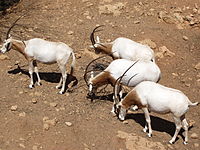 Arabian oryx roam in an open reserve.
Arabian oryx roam in an open reserve.
The traditional zoo infrastructure of bars and cages has been replaced by open areas separated from the public by trenches, moats, bridges, and glass windows; outdoor exhibits also have an indoor shelter in case of bad weather.[16] The only areas in which the public has direct contact with the animals are Lemur Land, the "petting pool" at the Wet Side Story aquatic exhibit, and the children's zoo, where children can pet and feed pygmy goats, sheep, rabbits and guinea pigs.
Animals and birds reside in natural habitats, from an African savannah to a tropical rain forest to the underground world of mice and cockroaches. The lesser kestrel exhibit is designed as a house in Jerusalem's Morasha district, formerly a major nesting ground for these birds.[8] Each animal or bird which is mentioned in the Bible has a biblical verse in Hebrew, Arabic and English appended to its information sign.[28]
Behind the scenes, the zoo operates an animal medical center with surgery, recovery and treatment rooms, a laboratory, and a quarantine unit where incoming animals and zoo animals being sent to other zoos are tested for diseases. This medical center cares for all zoo animals except the elephants, giraffes, rhinoceroses, hippopotamus, and bison, which are treated in their own exhibits.[29]
The parking lot accommodates 500 vehicles.[16] The city named the street astride the zoo Derech Aharon Shulov (Aharon Shulov Way) after the zoo's founder.[30]
Animal species
As of 2009, the zoo housed 2,200 animals representing 271 different species: 60 fish species, 68 mammal species, 28 reptile species, 11 amphibian species, and 104 bird species. Many species were introduced only in the last few years, as the collection numbered 208 species in 2007.[2]
Food sources
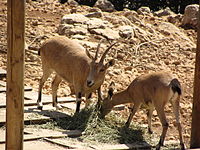 Nubian Ibex at feeding time.
Nubian Ibex at feeding time.
The massive amount of fruits and vegetables consumed daily by the zoo's animals are acquired free of charge through an agreement Shulov worked out with Israeli companies that tithe their produce in accordance with Jewish law.[10] In the absence of the Temple in Jerusalem, tithes from produce may not be given to a Kohen or Levite, but they may be fed to their animals. The Jerusalem Biblical Zoo, like others in Israel, sold its animals to a Kohen so it could receive the free produce distributed through the local religious council.[31][32] The meat consumed by the carnivores is furnished by kosher butchers, veterinarians, and fishermen.[10] Pruned branches from edible plants in the park, such as date palms, olive trees and carob trees, are also used for fodder.[33]
During Passover, the entire zoo is made chametz-free;[34] animals are fed matzo rather than bread products, and birds are fed rice.[35]
Themes and focus
Wildlife conservation
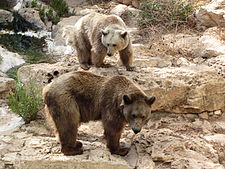 Syrian Brown Bears at the zoo.
Syrian Brown Bears at the zoo.
The zoo sees its primary goal as the conservation of endangered species.[36] These include animals mentioned in the Bible which are now extinct in Israel, such as the Asian lion, the Syrian Brown Bear, the cheetah, the Nile crocodile, and the Persian fallow deer.[37] It also includes endangered species worldwide, such as the Asian elephant, rare species of macaw,[37] the cockatiel, the ibis, and the Golden Lion Tamarin.
Towards that end, the zoo undertakes to breed animals in captivity and, in some cases, reintroduce them to the wild. Through this program, the zoo has successfully increased the number of Persian fallow deer in Israel. This species was thought to be extinct in the 20th century until a small number of deer were located in Iran in 1956. In 1978, four of these deer were brought to Israel and have since increased to several hundred, with a major breeding colony at the Jerusalem Biblical Zoo.[38] A concurrent project to protect the Negev tortoise from extinction involves breeding from artificially-incubated eggs.[39]
At the zoo's National Center for Artificial Incubation of Raptor Eggs, eggs of raptors that are either extinct or severely decimated in Israel are incubated from captive-breeding pairs.[39] The Griffon vulture, an endangered species, is the subject of much research activity. The zoo has successfully mated vultures with crippled wings – a feat that ornithologists previously thought could not be accomplished because these birds could not balance themselves properly.[40] It has also used two male vultures to hatch and raise chicks from incubated eggs.[41] Additionally, the zoo participates in a countrywide breeding program coordinated by the Israel Nature and Parks Authority to increase the birth rate of Griffon vultures in the wild.[42]
The zoo conducts a small ceremony each time it returns a bird to the wild. In 1996, for the release of a Griffon vulture which it named "Freedom", the zoo invited the mother of captured Israeli navigator Ron Arad to help release the bird.[43]
The zoo is considered a world leader and educator in reproductive intervention.[44] It achieved a major success in December 2005 with the birth of Gabi, the first elephant conceived in Israel through artificial insemination.[45] In conjunction with a team from the Reproduction Management Institute for Zoo Biology and Wildlife Research of Berlin, zoo veterinarians impregnated one of their female elephants, Tamar, with sperm obtained from Emmett, a bull elephant in the Whipsnade Animal Park, Bedfordshire, England.[44] On 10 December 2005, Gabi's six-hour birth was viewed by over 350,000 people in 108 countries via live streaming on the zoo's website.[1]
The zoo has also pioneered the use of animal birth control. It was the first to use a dart gun to implant a slow-release hormone into the thigh of a female giraffe; she is the daughter of the zoo's bull giraffe, and inbreeding is inadvisable. The zoo uses slow-release hormones to control its chimpanzee and mandrill populations, which are reproducing too quickly for the space they occupy; letting the animals multiply and sending family members to other zoos is unwise, according to veterinarians.[44]
Newborn animals that are threatened or ignored by their parents are raised by the veterinary staff. On December 31, 2008, for example, a newborn tiger cub ignored by its mother was taken home by a staff member to be raised and nursed by bottle.[46][47] A newborn leopard rejected by its mother spent its days at the zoo and nights at veterinarians' homes for its first three and a half months of life.[48]
The zoo also provides medical treatment for animals and birds injured in the wild.[49] The wildlife is either released back to their natural environment (if they are healthy enough) or placed in other zoos. In the late 2000s, an aviary was built for eagle owls which the zoo is nursing back to health.[39]
Public education
Public education is another prime focus of the zoo. According to Shai Doron, director-general of the zoo since 1993,[50] "Our moral right to exist comes from educating and raising the awareness of our visitors."[1]
Many Israelis, both Jewish and Arab, are not familiar with zoos and get "overexcited" at seeing the animals on display.[10] Dozens of zoo personnel man the displays during peak holiday times to stop visitors from throwing food and other items at the animals. The animals do have a preference for Bamba, the popular children's peanut-and-corn snack (though it gives the monkeys diarrhea); other common projectiles include bottles, plastic bags, children's shoes, and even knives.[51] In 1997 a toco toucan was found dead in its cage next to pieces of avocado, a known bird toxin.[51] In 2006 a hippopotamus died after swallowing a tennis ball tossed into its enclosure.[52] Over the past decade and a half, the zoo staff claims that public awareness has improved.[51]
Through visiting school groups, after-school groups, special-education groups and summer camps, children learn about and interact with the animals.[16] Educational activities for children, including the zoo's own youth movement, promote interracial encounters between Arab and Jewish youth.[53] The zoo also mounts a traveling workshop called the Zoomobile, which brings small animals in cages and a sound system carrying the sounds of larger animals to schools, hospitals, and other locations.[54]
Environmental awareness
The zoo teaches environmentalism both in its exhibits and by personal example. Since 1997[55] it has featured an "ecological maze"[25] – a short path meandering through high bushes with signs that highlight ecological challenges in Israel. In spring 2010 it unveiled a $1.5 million aquatic exhibit called "Wet Side Story"[56] which stresses the importance of water conservation, ecology awareness, and water challenges in the Middle East and around the world.[8] This exhibit displays rare and endangered marine life[56] in 17 large aquariums and three huge water tanks measuring 2 x 4 metres (7 x 14 ft). There is also an outdoor "petting pool" where visitors can touch and feed koi.[57]
In keeping with its "green" policy, the zoo maintains its own sewage treatment system and uses recycled water to irrigate its gardens. Food and animal waste are mixed with plant material and placed in large compost piles; the compost is used to fertilize the trees and shrubs.[8] The zoo sells its organic compost in the gift shop.[33] In 2006 receptacles for collecting used plastic drink bottles were installed next to each of the snack bars, and used batteries are collected at the gift shop.[49] To reduce carbon emissions and traffic, the zoo schedules the use of delivery and security vehicles.[33]
Research
The Jerusalem Biblical Zoo participates in national and international research projects in the fields of zoology, biology, and environmental science, and publishes papers in journals and at scientific meetings.[58][59][60][61][62] Through its Aharon Shulov Fund for the Study of Animals in Captivity, it also provides grants for research on animal welfare and husbandry, animal reintroduction, reproduction of endangered species, conservation genetics, and exotic animal nutrition and medical care.[63] The Fund is sponsored by Shulov's family, the Friends of the Zoo Association, and the Jerusalem Zoo.[64]
The zoo hosts academic seminars and student research at the Gabi Center, located in a 21-square-foot (2.0 m2) facility inside the main entrance. The center was named in memory of Dr. Gabi Eshkar, deputy director-general and chief veterinarian of the zoo for over 17 years, who was killed in an automobile accident in 2004.[65]
Affiliations
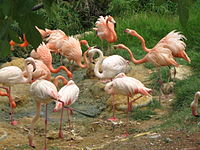 Flamingos at the zoo.
Flamingos at the zoo.
The Jerusalem Biblical Zoo is a full member of the European Association of Zoos and Aquaria (EAZA).[4] Zoo director-general Shai Doron is the only EAZA Council Member from Israel in the 2009–2012 season,[66] while general curator Shmulik Yedvab has been EAZA's European Endangered Species Programme project coordinator for the White-tailed sea eagle population of Europe and Asia since 1995.[44][67] The zoo is also a member of the World Association of Zoos and Aquariums (WAZA),[3] the Israel Zoo Association (which it helped form),[5] and the International Species Information System (ISIS).[6]
Members of the veterinary staff belong to the American Association of Zoo Veterinarians, the European Association of Zoo and Wildlife Veterinarians, and the European Group on Zoo Animal Contraception.[68]
Visitors and volunteers
A record 738,000 people visited the zoo in 2009.[2] The zoo does a brisk business in tourist groups, school groups, and summer camps: over 120,000 visitors arrived in groups in 2009. Included in the total are 63 groups of special-needs children, both Jewish and Arab,[49] who participate in weekly sessions of animal-assisted therapy.[8] Total capacity in the park is 11,000 visitors.[25]
Over 50 volunteers assist zoo operations on a weekly basis.[69] The zoo's youth movement, called Tnuat Noach (Hebrew: תנועת נח, "Noah's Movement"), involves teens aged 13–15 as volunteers in the children's zoo, small animal building, and bird and herbivores sections.[70] Members meet weekly with zoo staff and participate in hikes and expeditions in nature reserves.[71]
Special events
The zoo, which is open every day of the year except Yom Kippur, Yom HaShoah, and Yom Hazikaron, schedules special activities on selected dates. Tree-planting activities are an annual Tu B'Shevat tradition. On both days of Purim there is a parade, a family costume competition, and a tug of war between the entire Hapoel Jerusalem Basketball Team and one of the elephants (the elephant always wins). On Israel's Election Day, zoo goers are encouraged to vote for their favorite animal.[49] During the summer, the zoo conducts tours of nocturnal animals in the wee hours of the night. It also schedules jazz concerts, juggling, and workshops during school vacations.[72]
Expansion plans
Plans to enlarge the zoo to 400 dunams (99 acres) are now working their way through the approvals process. Among the proposed additions are a 2,000-square-metre (22,000 sq ft) educational center and an exhibit called Yemei Bereishit (In the Days of Genesis) which replicates Biblical conditions and excludes all modern devices, including cell phones and animal-keeping equipment. The $30 million expansion will be paid for by private donations.[1]
The master plan for expansion is drafted by the zoo's main planning body, the International Zoological Committee, which is staffed by professionals in wildlife conservation, zoo management, education, tourism and economics. This committee convened in 1993, before the reopening of the zoo, and again in 1996, when it drafted plans for adding additional animal exhibits and visitor attractions by 2010. The committee is scheduled to reconvene for the third time in November 2010 to plan land-use for the proposed expansion of the zoo to 400 dunams (99 acres).[1]
References
- ^ a b c d e f Stromberg, David (22 August 2010). "A Life of Its Own". The Jerusalem Post. http://www.jpost.com/Home/Article.aspx?id=112016. Retrieved 28 November 2010.
- ^ a b c d e Yelinek, Aviel (16 April 2010). "Animal Attraction". The Jerusalem Post. http://www.jpost.com/Home/Article.aspx?id=173247. Retrieved 28 November 2010.
- ^ a b "Member Zoos and Aquariums". World Association of Zoos and Aquariums. http://www.waza.org/en/site/zoos-aquariums. Retrieved 28 November 2010.
- ^ a b "EAZA Member Zoos and Aquariums". European Association of Zoos and Aquaria. 2010. http://www.eaza.net/membership/Pages/Zoos%20and%20Aquariums.aspx. Retrieved 28 November 2010.
- ^ a b Gleit, Heidi J. (2010). Redefining Zoos. ERETZ Magazine. http://www.eretz.com/NEW/zoo1.shtml. Retrieved 28 November 2010.
- ^ a b "Appendix F – ISIS Members". International Species Information System. December 2004. p. 37. http://forest.up.nic.in/ftikanpur/wltraining/international%20sps%20information%20system.pdf. Retrieved 28 November 2010.
- ^ Lis, Jonathan (1 April 2011). "Zoo managers from around the world go biblical in Jerusalem". Haaretz. http://www.haaretz.com/zoo-managers-from-around-the-world-go-biblical-in-jerusalem-1.353398. Retrieved 22 October 2011.
- ^ a b c d e "The Tisch Family Zoological Gardens Annual Report 2009". Jerusalem Foundation. 2009. http://www.jerusalemfoundation.org/uploads//Zoo%20report%202010.pdf. Retrieved 28 November 2010.
- ^ a b c d e f g h i Greenbaum, Avraham (August 2006). "The Jerusalem Biblical Zoo". Society of Biblical Literature. http://www.sbl-site.org/publications/article.aspx?articleId=579. Retrieved 28 November 2010.
- ^ a b c d e f g h Kammen, Michael (6 March 1983). "Jerusalem's Modern Ark". The New York Times. http://query.nytimes.com/gst/fullpage.html?sec=travel&res=9B03EFD71639F935A35750C0A965948260. Retrieved 28 November 2010.
- ^ Christian Victory. 56. The Company. 1982. p. 6. http://books.google.com/?id=hW_fAAAAMAAJ&q=Aharon+Shulov&dq=Aharon+Shulov.
- ^ Shulov, Aharon (1980). The Leopard. Jerusalem: The Jerusalem Zoo Educational Series, p. 13.
- ^ Grooters, Sarah (13 May 2010). "Doing Noah Proud". Houston Chronicle. http://www.chron.com/disp/story.mpl/life/religion/7003569.html. Retrieved 28 November 2010.
- ^ "The Tisch Family Biblical Zoo". Israel Ministry of Tourism. http://www.goisrael.com/Tourism_Eng/Articles/Attractions/The+Tisch+Family+Biblical+Zoo.htm. Retrieved 28 November 2010.
- ^ Shulov, Aharon (1981). The Wolf Shall Dwell with the Lamb: 40 years of the Jerusalem Biblical Zoo (in Hebrew). Jerusalem: Jerusalem Biblical Zoo, pp. 4–5.
- ^ a b c d e f g h Oestermann, Richard (June 1999). Born Again. Gefen Books. pp. 94–98. ISBN 978-9652292148. http://books.google.com/?id=bYsQvLkzRyoC&pg=PA96&dq=jerusalem+biblical+zoo+romema#v=onepage&q=jerusalem%20biblical%20zoo%20romema&f=false. Retrieved 28 November 2010.
- ^ Doron, Shai (4 February 2007). "The Zoo's No. 1 Friend". The Jerusalem Post. http://www.jpost.com/Home/Article.aspx?id=112016. Retrieved 28 November 2010.
- ^ "Israel". Price Family Charitable Fund. 2010. http://venetec.com/Israel/. Retrieved 28 November 2010.
- ^ a b c "About the Zoo". Jerusalem Zoo. 2010. http://www.jerusalemzoo.org.il/len/apage/11017.php. Retrieved 28 November 2010.
- ^ Vidmar-McEwen, Heather (18 June 2010). "Biblical Gardens Near Jerusalem, Israel". ehow.co.uk. http://www.ehow.co.uk/list_6640694_biblical-gardens-near-jerusalem_-israel.html. Retrieved 28 November 2010.
- ^ "The Biblical Zoo in Jerusalem – An Exciting Experience for Everyone". Yad Sarah. http://www.yadsarah.org/index.asp?id=162. Retrieved 28 November 2010.
- ^ "Biblical Zoo – The Tisch Family Zoological Gardens". Jerusalem Municipality. 22 March 2009. http://www.jerusalem.muni.il/jer_sys/picture/atarim/site_form_atar_eng.asp?site_id=18&pic_cat=4&icon_cat=6&york_cat=7. Retrieved 28 November 2010.
- ^ Hecht, Aaron (2009). "Bible Animals are Still Found in Israel". The Jerusalem Post. http://www.jposttravel.com/Christianity-in-Israel/Bible-animals.html. Retrieved 28 November 2010.
- ^ "Where the Wild Things Art". designistdream.com. 4 November 2007. http://designistdream.com/page/11/. Retrieved 28 November 2010.
- ^ a b c "Attractions in the Region: Jerusalem Biblical Zoo". Crowne Plaza. http://www.afi-hotels.com/Crowne_Plaza_Jerusalem_Attractions. Retrieved 28 November 2010.
- ^ "Niki de Saint Phalle Chronology (1930–2002)". ci.escondido.ca.us. http://www.ci.escondido.ca.us/events/califia/chronology.pdf. Retrieved 28 November 2010.
- ^ "Been There, Done That". The Independent Traveler. 2010. http://www.cruisecritic.com/ports/newport.cfm?ID=470. Retrieved 28 November 2010.
- ^ Marks, Harry. "Top 10: Zoos – Number 4: Jerusalem Biblical Zoo, Jerusalem, Israel". AskMen.com. http://ie.askmen.com/top_10/travel_top_ten/44c_travel_top_ten.html. Retrieved 28 November 2010.
- ^ "Zoo Hospital". Jerusalem Zoo. http://www.jerusalemzoo.org.il/len/apage/11019.php. Retrieved 28 November 2010.
- ^ "Zoos and Animal Farms". koogle.co.il. http://www.koogle.co.il/English/Businesses/Zoos--Animal-Farms. Retrieved 28 November 2010.
- ^ Slifkin, Nosson (1999). "The Torah Universe: Great Apes and Wild Men". Ohr Somayach International. http://ohr.edu/judaism/nature-apikorsas/natur007.htm.
- ^ Lyons, Craig. "The Biblical Tithe...Taught Correctly". Jewish Roots. http://jewishrootscx.netfirms.com/the_biblical_tithe.htm. Retrieved 28 November 2010.
- ^ a b c Kaufman, Dr. Elizabeth (June 2009). "Green Team". Profile (newsletter of the Tisch Family Zoological Gardens in Jerusalem). http://www.jerusalemzoo.org.il/var/360/312287-104.pdf. Retrieved 28 November 2010.
- ^ Burge, Beverly (2005). "Jerusalem Biblical Zoo is Kosher for Passover". myrehovot.info. http://myrehovot.info/eng/archive/2005_04_01_archive.html. Retrieved 28 November 2010.
- ^ Sofer, Barbara (13 May 2005). "57 More Reasons I Love Israel". The Jerusalem Post. http://www.highbeam.com/doc/1P1-109074626.html. Retrieved 28 November 2010.
- ^ "Animal Reintroductions". jerusalemzoo.org.il. http://jerusalemzoo.org.il/len/apage/11046.php. Retrieved 28 November 2010.
- ^ a b "Tisch Family Zoological Gardens". Fodor's. 2010. http://www.fodors.com/world/africa-and-middle-east/israel/jerusalem/review-190726.html. Retrieved 28 November 2010.
- ^ Heller, Aron (8 March 2006). "At the Zoo, Two-By-Two". Associated Press. http://www.aronheller.com/documents/articles/ap/ASAP/asap%20-%20biblical%20zoo.htm. Retrieved 28 November 2010.
- ^ a b c "Hey Deer, Have You Heard About the Happenings at the Tisch Family Zoological Gardens in 2007?". Jerusalem Foundation. 2007. http://www.jerusalemfoundation.org/uploads/%5Ccoexistence%5Cfrom%20arts%20to%20sports%5Ctisch%20zoological%20gardens%5CZoo%202007%20Annual%20Report.pdf. Retrieved 28 November 2010.
- ^ "Israeli scientists help vultures spread their wings". Israel21c. 6 June 2004. http://www.israel21c.org/technology/israeli-scientists-help-vultures-spread-their-wings. Retrieved 28 November 2010.
- ^ Harrison, Donald H. (7 April 2000). "Preying for peace". San Diego Jewish Press-Heritage. http://sandiegojewishworld.com/israel/the_golan/gamla_nature_reserve/sd4-7griffon_vulture.htm. Retrieved 28 November 2010.
- ^ Pomerantz, Batsheva (22 October 2009). "Waiting in the Wings". The Jerusalem Post. http://www.jpost.com/home/article.aspx?id=158327. Retrieved 28 November 2010.
- ^ Harrison, Donald H. (11 December 1998). "Judaic Park: S.D. Zoo helps Israel in quest to return biblical animals to the wild". San Diego Jewish Press-Heritage. http://sandiegojewishworld.com/israel/jerusalem/biblical_zoo/19981211-biblical_zoo.htm. Retrieved 28 November 2010.
- ^ a b c d Eisen, Sarah K. (28 June 2007). "Jerusalem Biblical Zoo a World Leader in Protecting Endangered Species". Israel21c. http://www.israel21c.org/environment/jerusalem-biblical-zoo-a-world-leader-in-protecting-endangered-species.
- ^ Lidman, Melanie (4 October 2010). "Israeli ‘aid ships’ carry 4-legged animals to Turkey". The Jerusalem Post. http://www.jpost.com/International/Article.aspx?id=190086. Retrieved 28 November 2010.
- ^ "One Big Kitten: Tiger cub at the Jerusalem Zoo". zooborns.com. 12 March 2009. http://www.zooborns.com/zooborns/jerusalem-biblical-zoo/. Retrieved 28 November 2010.
- ^ "Feb 27 Week in Photos: Tiger Cub, Pancake Race, More". Interesting Things. 2008. http://www.thewere.com/blog/2009/02/27/week-in-photos-tiger-cub-pancake-race-more/. Retrieved 28 November 2010.
- ^ "Dr. Elizabeth (Elisheva) Kaufman". Jewish Alliance for Women in Science. 2009. http://jawscience.webs.com/aprdrelishevakaufman.htm. Retrieved 28 November 2010.
- ^ a b c d "Tisch Family Zoological Gardens – 2006 Report". Jerusalem Foundation. 2006. http://www.jerusalemfoundation.org/uploads/%5Ccoexistence%5Cfrom%20arts%20to%20sports%5Ctisch%20zoological%20gardens%5Cthe%20tisch%20family%20zoo%20-%202006%20report.pdf. Retrieved 28 November 2010.
- ^ Saar, Yuval (17 September 2010). "The Human Zoo". Haaretz. http://www.haaretz.com/weekend/magazine/the-human-zoo-1.314357. Retrieved 28 November 2010.
- ^ a b c Alexander-Hurst, Nina (11 May 2006). "Beastly Behavior". The Jerusalem Post. http://www.jpost.com/home/article.aspx?id=21496. Retrieved 28 November 2010.
- ^ "Hippopotamus swallows ball, dies at Biblical Zoo". The Jerusalem Post. 5 May 2006. http://www.jpost.com/Home/Article.aspx?id=20914. Retrieved 28 November 2010.
- ^ "The Tisch Family Biblical Zoo". Israel Ministry of Tourism. 2005. http://www.goisrael.com/Tourism_Eng/Articles/Attractions/The+Tisch+Family+Biblical+Zoo.htm. Retrieved 28 November 2010.
- ^ Ben-David, Na'ama Y.. The Itinerant Ark: Insights from the Wandering Zoo. 50. International Zoo News. doi:October/November2003. http://www.zoonews.co.uk/IZN/328/IZN-328.htm. Retrieved 28 November 2010.
- ^ Dedication plaque at entrance to ecological maze.
- ^ a b Lis, Jonathan (23 May 2010). "Everything but the beach". Haaretz. http://www.haaretz.com/print-edition/features/everything-but-the-beach-1.291620. Retrieved 28 November 2010.
- ^ Julian, Hana Levi (17 November 2009). "'Wet Side Story' Opens at Jerusalem Biblical Zoo". resistnet.com. http://www.resistnet.com/group/istandwithisrael/forum/topics/if-pa-declares-state-israel?page=1&commentId=2600775%3AComment%3A1799042&x=1#2600775Comment1799042. Retrieved 28 November 2010.
- ^ Ofri, Ron; Barishak, Robert Y.; Eshkar, Gabi; Aizenberg, Itzhak (March 1996). "Feline Central Retinal Degeneration in Captive Cheetahs (Acinonyx Jubatus)". Journal of Zoo and Wildlife Medicine 27 (1): 101–108. JSTOR 20095551.
- ^ Burge, Beverly; Mumcuoglu, Madeleine; Simmons, Tal (1999). "The Effect of Sambucol on Flu-like Symptoms in Chimpanzees: Prophylactic and symptom-dependent treatment". International Zoo News 46 (1): 16–19. http://www.mivelle.hu/sambucol/Effect%20in%20Chimpanzees.pdf. Retrieved 28 November 2010.
- ^ Eshkar, G.; Avni-Magen, N.; Ofri, R. (31 May-4 June 2000). "Periodic Recurrent Keratitis in Asian Elephants". European Association of Zoo and Wildlife Veterinarians, Third Scientific Meeting. http://library.vetmed.fu-berlin.de/resources/global/contents/VET164623/EAZWV/Parijs%20PDF/Microsoft%20Word%20-%20Eshkar.pdf. Retrieved 28 November 2010.
- ^ Avni-Magen, Nili; Elad, Daniel; Friedman, Michael; Gati, Irith; Kaufman, Elizabeth; Lavy, Eran (March 2008). "Use of a sustained release preparation of clotrimazole to treat dermatophytosis in a siamang (Hylobates syndactylus)". Journal of Zoo and Wildlife Medicine 39 (1): 115–117. doi:10.1638/2007-0018.1. PMID 18432106. http://lib.bioinfo.pl/pmid:18432106.
- ^ Bakal-Weiss, Meytal; Steinberg, Doron; Friedman, Michael; Gati, Irith; Avni-Magen, Nili; Kaufman, Elizabeth; Lavy, Eran (June 2010). "Use of a Sustained Release Chlorhexidine Varnish as Treatment of Oral Necrobacillosis in Macropus spp". Journal of Zoo and Wildlife Medicine 41 (2): 371–373. doi:10.1638/2010-0004.1. PMID 20597238. http://zoowildlifejournal.com/doi/abs/10.1638/2010-0004.1.
- ^ "List of research projects". Jerusalem Biblical Zoo. http://www.jerusalemzoo.org.il/len/apage/11400.php. Retrieved 28 November 2010.
- ^ "Shulov Fund". Jerusalem Zoo. http://www.jerusalemzoo.org.il/len/apage/11047.php. Retrieved 28 November 2010.
- ^ "Gabi Center". Jerusalem Zoo. http://www.jerusalemzoo.org.il/len/apage/11020.php. Retrieved 28 November 2010.
- ^ "Council Members 2009–2012". EAZA. http://www.eaza.net/about/About%20EAZA%20Documents/Council_09-12.pdf. Retrieved 28 November 2010.
- ^ "Complete List of EEPs and ESBs". EAZA. 2010. http://www.eaza.net/activities/cp/Pages/EEPs.aspx. Retrieved 28 November 2010.
- ^ "Alphabetized Institution List". egzac.org. 2010. http://www.egzac.org/Admin/institutions.aspx. Retrieved 28 November 2010.
- ^ "Volunteering". Jerusalem Zoo. http://www.jerusalemzoo.org.il/index.php?lang=en&act=page&id=11049&str=volunteers. Retrieved 28 November 2010.
- ^ "Zoo names a lake for Ellen Barnett". San Diego Jewish Press-Heritage. 27 July 2001. http://www.jewishsightseeing.com/israel/jerusalem/jerusalem_zoo/sd7-27-01jerusalem_zoo.htm. Retrieved 28 November 2010.
- ^ "The Zoo Youth Group". Jerusalem Zoo. http://www.jerusalemzoo.org.il/len/apage/11041.php. Retrieved 28 November 2010.
- ^ "Biblical Zoo". funinjerusalem.com. 23 February 2010. http://www.funinjerusalem.com/fun-list-categories/106-biblical-zoo.html49353-kids20with20sheep/?lang=en&font-size=smaller. Retrieved 28 November 2010.
External links
- Official website
- Official website (Hebrew)
- Official website (Arabic)
- Virtual tour of the Jerusalem Biblical Zoo
- Extinct and Endangered Animals in Palestine
Zoos, aquariums, and aviaries Types of zoos Conservation Lists Animals Other topics - Animals in captivity
- Animal training
- Behavioral enrichment
- Captive breeding
- Frozen zoo
- Immersion exhibit
- Nocturnal house
- Wildlife conservation
- Zookeeper
- Zoology
- Portal
- Project
- Category
- Commons
Categories:- Zoos in Israel
- 1940 establishments
- Buildings and structures in Jerusalem
- Animal reintroduction
Wikimedia Foundation. 2010.

